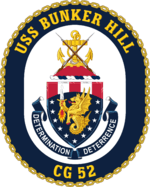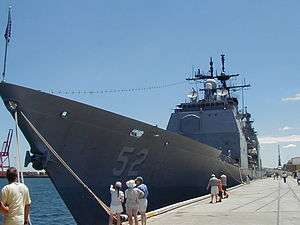USS Bunker Hill (CG-52)
 USS Bunker Hill (CG-52) underway | |
| History | |
|---|---|
| Name: | USS Bunker Hill |
| Namesake: | Battle of Bunker Hill |
| Ordered: | 15 January 1982 |
| Builder: | Ingalls Shipbuilding |
| Laid down: | 11 January 1984 |
| Launched: | 11 March 1985 |
| Commissioned: | 20 September 1986 |
| Homeport: | Naval Base San Diego |
| Identification: | CG-52 |
| Motto: | Determination, Deterrence |
| Nickname(s): | "Bravo" |
| Honors and awards: | 7 Battle "E" Awards |
| Status: | in active service |
| Badge: |
 |
| General characteristics | |
| Class and type: | Ticonderoga-class cruiser |
| Displacement: | Approx. 9,600 long tons (9,800 t) full load |
| Length: | 567 feet (173 m) |
| Beam: | 55 feet (16.8 meters) |
| Draft: | 34 feet (10.2 meters) |
| Propulsion: |
|
| Speed: | 32.5 knots (60 km/h; 37.4 mph) |
| Range: | 6,000 nmi (11,000 km) at 20 kn (37 km/h); 3,300 nmi (6,100 km) at 30 kn (56 km/h). |
| Complement: | 33 officers, 27 Chief Petty Officers, and approx. 340 enlisted |
| Sensors and processing systems: |
|
| Armament: |
|
| Aircraft carried: | 2 × Sikorsky SH-60B or MH-60R Seahawk LAMPS III helicopters. |
| Aviation facilities: | Hangar bay, flight deck |
USS Bunker Hill (CG-52) is a Ticonderoga-class guided missile cruiser of the United States Navy laid down by Litton-Ingalls Shipbuilding Corporation at Pascagoula, Mississippi on 11 January 1984, launched on 11 March 1985 and commissioned on 20 September 1986. Bunker Hill is homeported at Naval Base San Diego in San Diego, California.
Bunker Hill was the first Ticonderoga-class cruiser to be equipped with the Mark 41 Vertical Launching System (VLS) in place of the previous ships' twin-arm Mark 26 missile launchers, which greatly improved the flexibility and firepower of the ships by allowing them to fire RGM-109 Tomahawk missiles.
Ship's Coat of Arms
The sea dragon is an awesome beast that is both vigilant and fierce. Grasping a flaming sword, the sea dragon symbolizes the naval prowess and attack capability of the USS Bunker Hill. The flaming sword also represents the revolutionary capability of the vertical launching system first introduced in Bunker Hill. The stars commemorate the eleven battle stars the former USS Bunker Hill (CV-17) earned in the Pacific theater during World War II. Blue and gold are the colors traditionally associated with the Navy and are symbolic of the sea and excellence. The two white bars in the chief represent American courage and purpose as displayed at the Battle of Bunker Hill on 17 June 1775. The red bars symbolize the British assaults on the colonists' entrenchment and the curve below alludes to the hill that the British took at great cost. Battle of Bunker Hill proved to be a rallying point for the Americans, since afterwards the British faced full-scale war. The colonists were formidable opponents at Bunker Hill. The entrenchments or redoubts they built are symbolized by the scarlet hill and battlements. The muskets with bayonets recall the weapons of that battle and the powder horn refers to the New Englander's stand until their ammunition supply was exhausted. The anchor is symbolic of maritime traditions and excellence of achievement.
1980s
After commissioning in Charlestown, MA in the shadow of the USS Constitution, Bunker Hill entered the Pacific Ocean via the Panama Canal and began short notice work-ups to deploy to the U.S. Seventh Fleet. She made her first deployment in July 1987, nearly one year ahead of schedule.
During READIEX 87-5, Bunker Hill first operated with Battle Group Sierra which consisted of Commander, Cruiser-Destroyer Group 1, the battleship Missouri, cruiser Long Beach, destroyer Hoel, frigate Curts, and supply vessel Kansas City. She deployed as part of Battle Group SIERRA (Task Group 30.7).[1] Following an upkeep period at Subic Bay in the Philippines, Bunker Hill became Anti-Air Warfare Coordinator for Battle Group Sierra (TG 70.10), now en route to the North Arabian Sea and Gulf of Oman. During the deployment she provided an anti-air warfare umbrella inside the Persian Gulf for Missouri and other US-flagged tankers and ships transiting through the Strait of Hormuz.
In August 1988, Bunker Hill's homeport was shifted from San Diego to Yokosuka, Japan joining the Midway Carrier Battle Group. She then deployed with the Midway group for four months with the Seventh Fleet, for which she was awarded the Meritorious Unit Commendation. She was also awarded her first Battle Efficiency Award.
1990s and 2000s
In November 1990, Bunker Hill sailed in support of Operation Desert Shield and Operation Desert Storm and served as the multinational Air Warfare Commander (AAWC) and as one of the first ships to launch a Tomahawk Land Attack Cruise Missile against Iraqi targets. Following the conclusion of the Persian Gulf War, Bunker Hill participated in organizing and establishing Operation Southern Watch, the complex enforcement of the United Nations established no-fly zone over southern Iraq. Bunker Hill made a historical visit to the Russian city Vladivostok in 1993, and then one year later she made a port visit to Qingdao in the People's Republic of China.
In March 1996, during the Third Taiwan Strait Crisis, she took station south of Taiwan to monitor missile tests by the People's Liberation Army.
In July 1998, Bunker Hill's homeport was shifted from Yokosuka, Japan back to San Diego. In late 2000, Bunker Hill deployed with the Abraham Lincoln Battle Group. She again participated in Operation Southern Watch and conducted boardings and inspections of over 40 merchant vessels in support of United Nations sanctions against Iraq. Bunker Hill also escorted the Tarawa Amphibious Ready Group while conducting humanitarian operations off East Timor and training exercises in Kuwait. Bunker Hill acted as Air Defense Commander for the ARG where she designed and implemented innovative procedures for CG integration into an Amphibious Ready Group. Following the attack on the destroyer USS Cole, Bunker Hill sortied from Bahrain to provide support and protection to seven United States Navy and United States Naval Ships (auxiliary vessels) based there and subsequently remained at sea for 67 consecutive days. Bunker Hill returned from deployment in February 2001.
Since her commissioning, Bunker Hill has deployed six times to the Persian Gulf and has earned fifteen Battle "E" Awards, including the Golden Battle "E" in 1996 and 2006 which is given when a ship receives five such awards consecutively.

In March 2006, it was announced that Lockheed Martin would upgrade the Aegis Combat System on 22 navy vessels; Bunker Hill was the first slated to receive the upgrade.
In March 2003, Bunker Hill was assigned to Cruiser-Destroyer Group 3.[2] Bunker Hill went on to fire a total of 31 Tomahawk missiles in support of Operation Iraqi Freedom.
In January 2007, Bunker Hill was sent to the coast of Somalia to conduct anti-terrorist operations as part of the Dwight D. Eisenhower task force. She was awarded the Meritorious Unit Citation for this role.
On 28 February 2008, Bunker Hill was awarded the 2007 Battle "E" award, her 6th consecutive Battle "E".[3]
From 1 October 2009, Bunker Hill was assigned to Carrier Strike Group One, whose flagship was the aircraft carrier Carl Vinson.[4]
2010s
In January 2010, Bunker Hill headed toward Haiti, part of the US Navy's force providing disaster relief after the 2010 Haiti earthquake.[5]
In February 2011, Bunker Hill along with the destroyer Momsen broke up a pirate attack on a tanker while patrolling the Gulf of Oman. The ships chased away two skiffs, eventually sinking both after they had returned to their mothership.[6]
In 2011-2012 the ship deployed with Carrier Strike Group One. On 22 October 2012, Bunker Hill began a five-month Drydocking Selected Restricted Availability (DSRA) maintenance period at the BAE Systems Inc. shipyard in San Diego, California.[7]
Bunker Hill is slated to be decommissioned in 2019 with 33 years of service and placed in reserve. She will be the first VLS Ticonderoga to be decommissioned.[8]
Notes
- ↑ USS Bunker Hill Command History 1987
- ↑ Toppan, Andrew (10 March 2003). "World Navies Today: US Navy Aircraft Carriers & Surface Combatants". hazegray.org. Retrieved 14 May 2014.
- ↑ Velazquez, Elena (4 March 2008). "COMNAVSURFOR Announces Winners of Battle "E"". Naval Surface Forces Public Affairs. Retrieved 14 May 2014.
- ↑ "Navy Establishes Carrier Strike Group 1". NNS091002-03. Commander, U.S. 3rd Fleet Public Affairs. 2 November 2009. Retrieved 2010-08-23.
- ↑ Fuentes, Gidget (16 January 2010). "Bunker Hill en route to help Haiti mission". Navy Times. Retrieved 16 January 2010.
- ↑ "U.S. Navy disrupts pirate attack". CNN. 4 February 2011. Retrieved 15 February 2011.
- ↑ "2012 History". USS Bunker Hill CG-52. USCarrier.net. 26 October 2012. Retrieved 2011-12-07.
- ↑ "Report to Congress on the Annual Long-Range Plan for Construction for Naval Vessels for FY2015" (PDF). Washington DC: Office of Chief of Naval Operations. June 2014. p. 19.
External links
| Wikimedia Commons has media related to USS Bunker Hill (CG-52). |
- Official website
- U.S. Navy Story Archive, USS Bunker Hill (CG-52)
- USS Bunker Hill webpage
This article includes information collected from the Naval Vessel Register, which, as a U.S. government publication, is in the public domain.